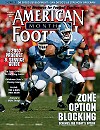AMERICAN FOOTBALL MONTHLY THE #1 RESOURCE FOR FOOTBALL COACHES
Article CategoriesAFM Magazine
|
The Spin Offense: The Running Game (Part II)The greatest offense you\'ve never heard of...by: Mike Kuchar © More from this issue When Dale Weiner and his staff at Catholic High School in Baton Rouge (LA) developed the “spin offense” as their primary offense in 2001, there were three aspects that they felt needed to be accomplished in order to be successful: develop a base run package with complimentary play-action off of it; keep the defense on its toes by using misdirection and motion; and keep it simple enough so that the players and coaches can make adjustments on the fly. Although the system is quite simple, because of complex appearance of the spin, Catholic high typically will have a defense of the week set up for them every time they take the field. “We haven’t seen the same type of defense two weeks in a row for the last four years. So keeping our concepts simple makes the most sense,” says Weiner. The basis of the run game, ac....The full article can only be seen by subscribers. Subscribe today!
|
|
|||||||
| HOME |
MAGAZINE |
SUBSCRIBE | ONLINE COLUMNISTS | COACHING VIDEOS |
Copyright 2025, AmericanFootballMonthly.com
All Rights Reserved





